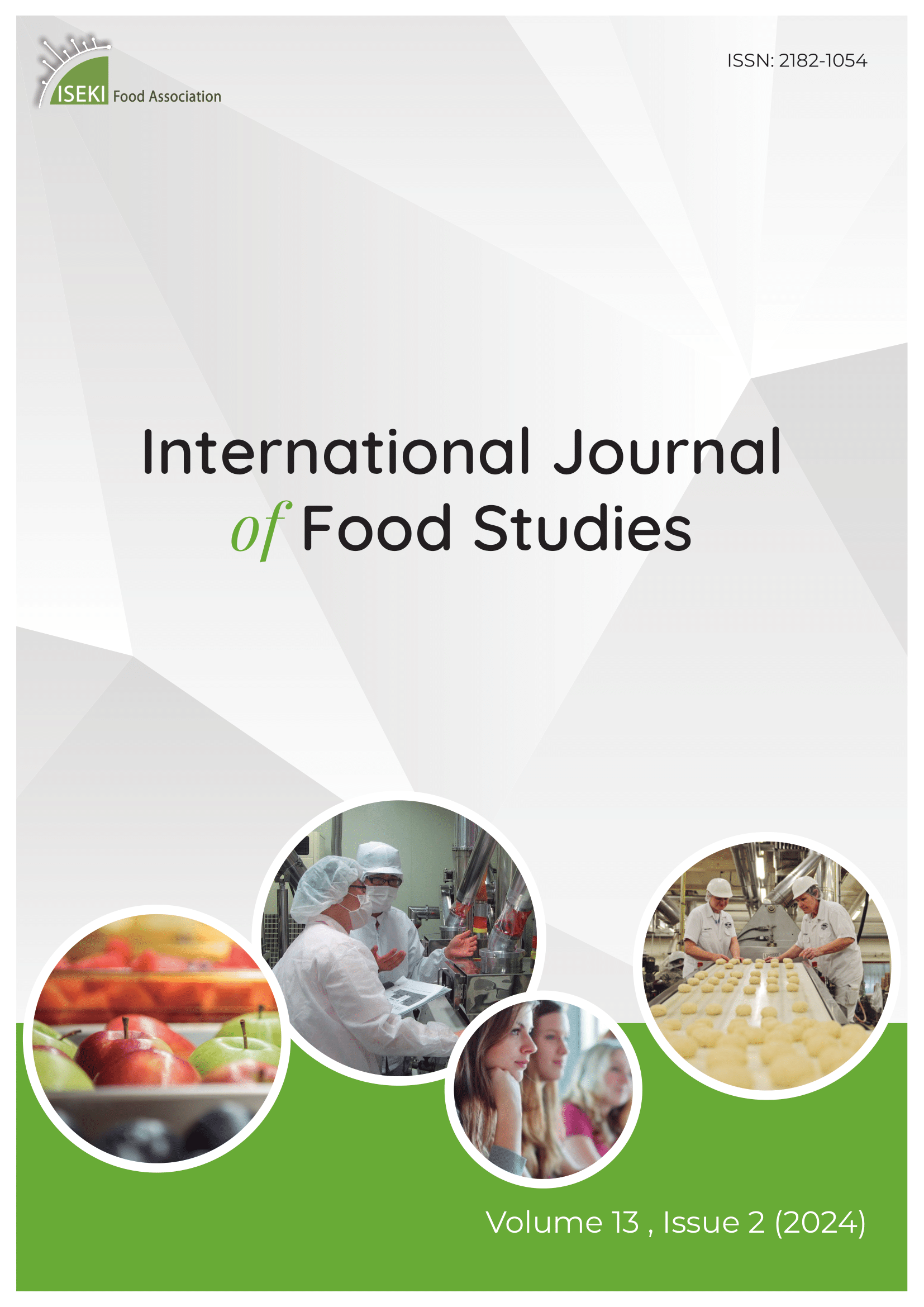Current issue

Volume 13, Issue 2, 2024
Online ISSN: 2182-1054
Volume 13 , Issue 2, (2024)
Published: 18.10.2024.
Open Access
All issues
Contents
18.01.2020.
Original scientific paper
Optimization of pressure parboiling conditions and pre-conditioned moisture content of brown rice (unpolished rice) for microwave puffing and its comparison with hot sand bed puffing
Brown rice puffing (unpolished rice) gives a more nutritious product compared to traditional puffed polished rice and reduces the cost of the product significantly, even though, the rice bran layer resists expansion during puffing. In the present study, brown rice was puffed in a microwave and hot-sand-bed after its pressure parboiling. Pressure parboiling parameters, steam pressure (196, 294, 392, 490 kPa) and steaming time (5, 10, 15 min), along with pre-conditioned moisture content (8, 10, 12 % wb) were studied and optimized for puffing characteristics (puffing percentage, expansion ratio, whiteness index, bulk density and hardness). All the experiments were carried out using a full factorial design. Statistical analysis showed there was a significant effect of processing variables on puffing characteristics. Optimized steam pressure, steaming time and pre-conditioned moisture content for microwave puffing were found to be 303.6 kPa, 14.25 min and 11.6% (wb) respectively, and for hot-sand-bed puffing to be 260.7 kPa, 15 min and 8% (wb) respectively.
Ajay Swarnakar, Prem Prakash Srivastav, Susanta Kumar Das
24.02.2021.
Original scientific paper
Study of Antimicrobial, Antioxidant and Cytotoxicity Properties of Selected Plant Extracts for Food Preservative Applications
An attempt has been made to evaluate antimicrobial, antioxidant and cytotoxicity properties of extracts from onion (Allium cepa L.), garlic (Allium sativum), leaves of guava (Psidium guajava), papaya (Carica papaya), tea (Camellia sinensis), baen (Avicennia alba) and keora (Sonneratia apetala), respectively to apply as natural preservatives for tomatoes. The air-dried plant materials of the respective plant species were subjected to ethanol-methanol extraction, concentrated and stored at 4 °C before use. The extracts were dissolved in 95% ethanol for analysis of antioxidant and antimicrobial properties. Of the extracts tested, tea extracts showed the highest zone of inhibition against several pathogenic bacteria (E. coli 35.0±3.2 mm; P. aeruginosa 29.3±2.6 mm; S. typhi 28.4±2.1 mm and S. pyogenes 27.7±3.7 mm) using the disc diffusion method. In regard to DPPH free radical scavenging assay, keora and guava extracts showed the highest percentage of radical scavenging activity with the values of 89.64± 0.18 and 89.39± 0.88, respectively, which were in agreement with higher total antioxidant capacity (TAC) of these extracts obtained by the phosphomolybdenum method. Brine shrimp lethality bioassay for cytotoxicity assessment showed LC50 of 132.54 ± 18.99 µg/mL for the leaf extract of keora which was found to be most toxic among all studied extracts. The initial results indicated that the extracts could be used for food preservative applications based on the antimicrobial, antioxidant and cytotoxicity properties of the tested extracts. However, efficacy, stability and safety issues need to be addressed with both in vitro and in vivo studies.
Md. Nazrul Islam, Md Nazrul Islam, Wahidu Zzaman, Md Morsaline Billah
18.01.2020.
Original scientific paper
Evaluation of gum arabic from Acacia senegal var kerensis and Acacia senegal var senegal as a stabilizer in low-fat yoghurt
Gum arabic is a dried, gummy exudate obtained from the stems and branches of Acacia senegal and Acacia seyal. In Kenya, gum arabic comes from Acacia senegal var kerensis although its exploitation for commercial and industrial application is marginal. Therefore, the aim of this study was to characterize and determine the effect of the gum from A. senegal var kerensis on the quality characteristics of set low-fat yoghurt compared to gum arabic from A. senegal var senegal, with a view to increasing its utilization locally. Yoghurt was prepared containing gum arabic at four concentrations (0.2%, 0.4%, 0.6%, 0.8% gum w/v). Results showed that A. senegal var kerensis gum had higher molecular weight and gelling properties compared to A. senegal var senegal gum. In addition, A. senegal var kerensis gum was less susceptible to syneresis and showed a higher absolute viscosity compared to A. senegal var senegal gum at all concentration levels. Sensory evaluation revealed that addition of gum arabic significantly improved the body and the texture of the yoghurt. Therefore, A. senegal var kerensis gum is a better yoghurt stabilizer than gum arabic from A. senegal var senegal. An optimal gum concentration of 0.6% of A. senegal var kerensis gum in low-fat yoghurt is recommended from the results of this study.
Edward Muita Mugo, Symon M. Mahungu, Ben N. Chikamai, Johnson Mwove
18.01.2020.
Original scientific paper
Textural, rheological and sensory properties of spreadable processed goat cheese
The aim of this work was to study the influence of the ripening degree of natural goat cheese on texture, rheological and sensory properties of processed cheese products. Processed cheeses were formulated using goat cheeses with 10, 20, and 40 days of ripening. We obtained four different formulations by varying the proportions of these cheeses in each formulation. The variation in major α, β, and para-κ casein fractions, rheological properties, and the texture of samples were determined, and a sensorial evaluation was carried out. Cheeses from Formulation 2 (50% cheese ripened for 10 days, 25% cheese ripened for 20 days and 25% cheese ripened for 40 days) had greater values of α and β –caseins, which is related to a greater content of intact casein resulting from a cheese with short ripening time. Hardness, adhesiveness and complex modulus (G*) decreased as the degree of ripening of the natural cheese (raw material) increased. Formulation 2 presented a G* value similar to that of the commercial processed cow cheese and the greatest firmness. Formulation 2 presented the characteristics we aimed to obtain, described as spreadable, slightly acid and salty cheese.
Laura Burgos, Nora Pece, Silvina Maldonado
18.01.2020.
Original scientific paper
Various factors affect product properties in apple cider production
Different parameters in cider processing were evaluated using different cultivars of Norwegian-grown table apples measuring the quality of cider. Seven different apple cultivars were mixed into four different apple juice mixtures. In this experiment, we evaluated the maturation of the apples along with commercial cider yeast and spontaneous alcoholic fermentation. Other parameters were fermentation temperature and filtration along with content of polyphenols, organic acids and volatile compounds that was analysed as an effect of the fermentation process. Succinic acid was the major organic acid in apples and ciders. The different apple juice mixtures did not reveal pyruvic and acetic acids but they appeared in relatively high amount in the ciders. The level of citric acid increased from apple to cider. Chlorogenic acid was the major polyphenolic compound found from 13-109 mg L-1 in the apple juice mixtures and between 27-200 mg L-1 in the ciders. The higher alcohol 3-methyl-1-butanol appeared in relatively large amounts in all the ciders (91-166 mg L-1). The average content of acetaldehyde increased during the fermentation process, from apple juice mixtures 2.75 mg L-1 and 14.65 mg L-1 in the ciders. The content also increased for ethyl acetate with levels at 0.1 mg L-1 in the apple juice mixture and 20 mg L-1 in the cider. In the sensory evaluation experiment, the ciders produced from the apple cultivars Aroma, Gravenstein and Summerred got higher scores in fruitiness and complexity compared to the other apple juice mixtures.
Trude Wicklund, Elizabeth R. Skottheim, Siv F. Remberg
18.01.2020.
Original scientific paper
Evaluation of the effectiveness of cereal bran extract for sunflower oil stability during frying
This study evaluated the effectiveness of black rice, millet and barley bran extracts against oxidative degradation of sunflower oil in frying, by determining the total antioxidant activity, total phenolic content, free fatty acid content, conjugated diene content and total polar content. It was reported that the total phenolic content rice bran was approximately three times higher than that of the millet bran extracts and five times higher than the results for barley bran extracts. The total antioxidant activity results for barley bran and rice bran extract (40.95 ± 0.07and 40.87 ± 0.04 Trolox equivalent μmol/g of bran, respectively) were two times higher than that of millet bran extract (17.16 ± 0.34 Trolox equivalent μmol/g of bran). The results of the effectiveness of the cereal bran extracts were significantly different (p<0.05). The free fatty acid content of the rice bran and propyl gallate enriched oil samples showed better results (2.02 ± 0.01% and 1.62 ± 0.00%) than millet, barley and control enriched oil samples (3.43 ±0.01%, 3.13±0.01% and 6.13 ± 0.01% respectively). In the same vein, conjugated diene content results from all the enriched oil samples indicated that the rice bran enriched oil sample had the least amount of secondary oxidized products compared to the other enriched oil samples. It can be concluded that rice bran extract can be used for frying without discarding or replenishing the oil.
Abayomi W. Ajala, Abdollah Ghavami
24.02.2021.
Original scientific paper
Effect of Emulsifier Diacetyl Tartaric Acid Ester of Mono- and Diglycerides (DATEM) and Enzyme Transglutaminase on Quality Characteristics of Rice Bran Croissants
Rice bran (RB) is a good source of dietary fibre. Addition of rice bran into croissant interferes with the gluten formation of dough and hence affect the physicochemical properties of croissant. The effect of RB addition on physicochemical properties of croissant were determined by using 0%, 10% and 15% RB. Besides, additives such as emulsifiers and enzymes can be used in pastry to enhance the physicochemical properties of croissant. Diacetyl tartaric acid ester of mono-diglycerides (DATEM) and transglutaminase (TGase) were used respectively on 0%, 10% and 15% RB to investigate the effect of such additives on physicochemical properties of croissant. Increased % RB and DATEM, produced a significant decrease in specific volume, together with a significant increase in colour, hardness and chewiness. With increased % RB, TGase caused significant increase in colour, hardness and chewiness but significant decrease in specic volume. The overall moisture sorption isotherm curves of the croissant belong to the Type III isotherm, also known as Flory-Huggins Isotherm (J-shaped). The critical aw obtained from the Guggenheim-Anderson-de Boer (GAB) equation showed that the shelf life of croissants were not positively impacted by the addition of DATEM and TGase and the addition of RB did not cause any significant positive effects on quality characteristics of croissants.
Wan Zunairah Wan Ibadullah, Aw Ying Hong, Mahmud Ab Rashid Nor-Khaizura, Nor Afizah Mustapha, Z. A. Nur Hanani, Mohammad Rashedi Ismail-Fitry, Anis Shobirin Meor Husin
24.02.2021.
Original scientific paper
Effect of Taro (Colocasia esculenta) Enrichment on Physicochemical and Textural Properties of Cake
Taro is a plant widely produced in tropical areas for its underground corms and it is used mainly as a vegetable. Its physicochemical, sensory properties and health benefits led to its use in value-added products. The cake is a high value-added bakery product and it needs a lower amount of gluten protein, therefore, taro flour (TF) was supplemented in wheat flour (WF) at different levels (10, 20, 30 and 40%). In connection with this, the incorporation of taro flour into wheat-based products has been reported to increase their nutritional and textural quality. The taro-supplemented cake showed higher mineral and fiber content, however, reduced caloric value. It was observed that taro supplementation reduced gluten and protein content and had higher oil and water binding capacity, therefore suitable for cake preparation. Taro cake had improved texture and sensory characteristics in comparison to wheat cake. It can be concluded that addition of taro for cake preparation improves nutrition and quality characteristics, therefore, it can be recommended to use taro for cake preparation.
Anuj Saklani, Ravinder Kaushik, Prince Chawla, Naveen Kumar, Mukul Kumar
24.02.2021.
Original scientific paper
Chemical Characteristics and Sensory Properties of Novel Snacks Produced with Okara Fortified with Omega-3 from Fish Oil
The aim of the present work was to develop a new soy-based food product and evaluate its chemical and sensory properties. A soy-based snack was mixed with rice (Oryza sativa), fortified with eicos-apentaenoic acid (EPA) and docosahexaenoic acid (DHA) Omega-3 fatty acids from sh by-products in encapsulated and emulsion form. Soy beans were subjected to grinding processes, maceration in pure distilled water, filtration and pasteurization, to obtain vegetable drinks and generate solid residue. Finally, a sensory analysis of the product obtained was carried out. The snacks protein content was around 17%. From the sensory evaluation, it could be concluded that the snacks with 50% of okara had great acceptability and the addition of Omega-3 was also acceptable. So, okara represents an excellent raw material that can be utilized for dietary protein fortification. On the other hand, it proposes based on soy and fish by-products allow sustainable development and contribute to the economy of each sector.
Trinidad Sandra Álvarez, Daniela Lorena Lamas
24.02.2021.
Original scientific paper
The Effect of Seaweed (Eucheuma cottonii) Flour Addition on Physicochemical and Sensory Characteristics of an Indonesian-Style Beef Meatball
The objective of this work was to study the effect of seaweed (Eucheuma cottonii) our addition on physicochemical and sensory characteristics of an Indonesian-style beef meatball. Seaweed flour (SF) was added to meatball batter at 0% (CON), 2.5% (SF2.5), 5.0% (SF5) and 7.5% (SF7.5) in weight/meat weight (w/w) basis. Proximate composition (moisture, crude protein, crude fat, crude fiber and ash content), pH, cooking loss, hardness, water-holding capacity, instrumental color and sensory properties (color, texture, aroma, taste and overall acceptability) of the boiled meatballs were evaluated. The effect of seaweed our addition was very significant (P<0.01) on moisture, crude fat, crude fiber, ash, cooking loss, hardness, water holding capacity, lightness (L*), yellowness (b*) and all sensory properties, and was significant (P<0.05) on crude protein, pH and the redness (a*) of a boiled Indonesian-style beef meatball. The addition of seaweed flour at more than 2.5% resulted in darker meatballs, with less protein and fat, and a stronger seaweed aroma. The results suggest that seaweed flour could be added at 2.5% (w/w) to produce an Indonesian-style beef meatball with enhanced ber content.
Aris Sri Widati, Djalal Rosyidi, Lilik Eka Radiati, Happy Nursyam











